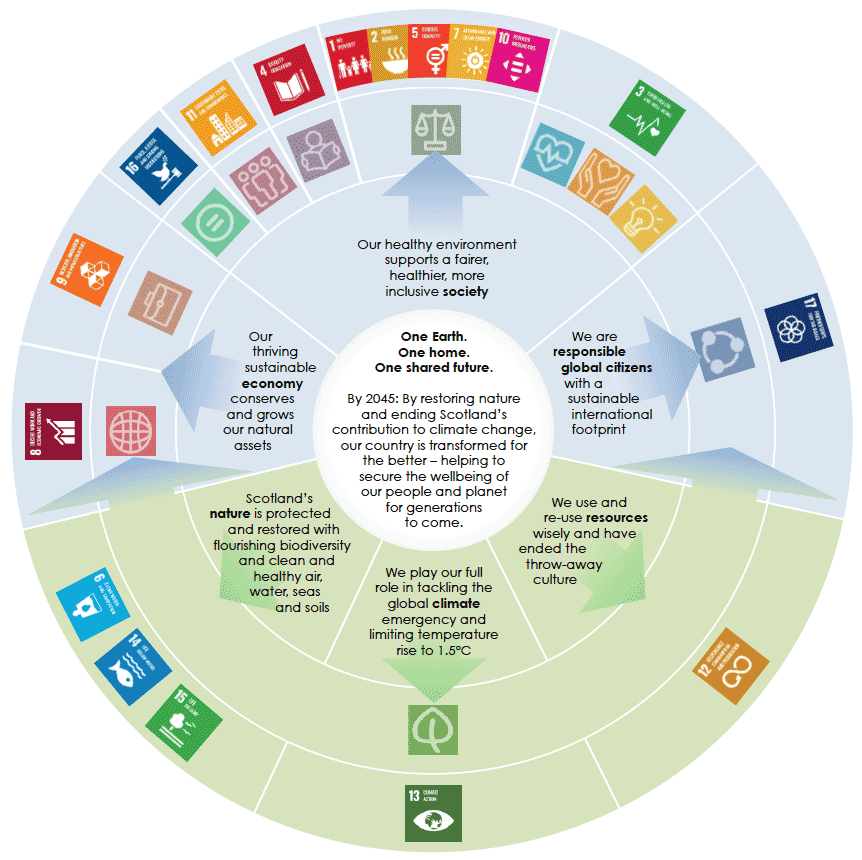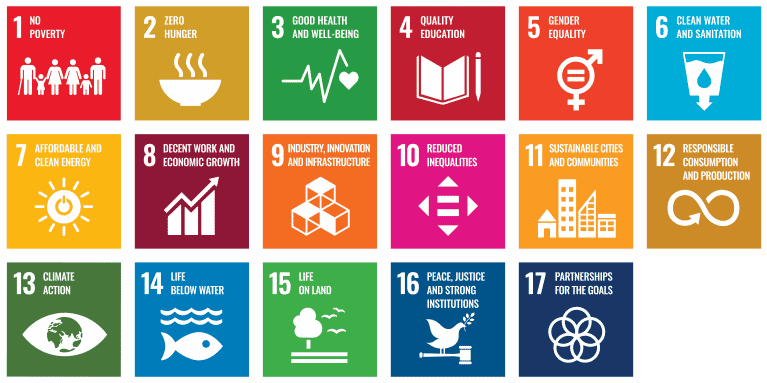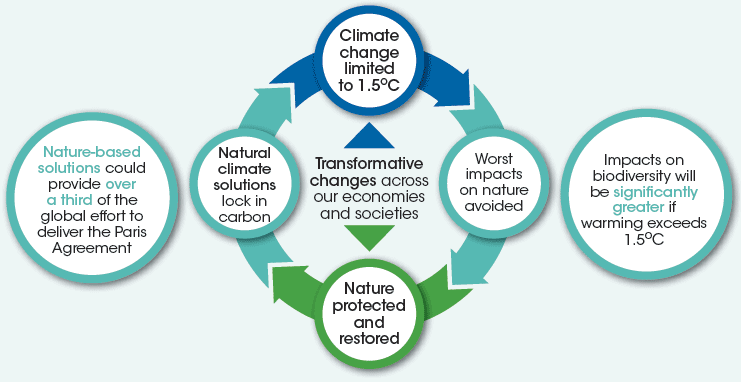The Environment Strategy for Scotland: vision and outcomes
Overview of the Environment Strategy for Scotland’s long-term vision and supporting outcomes.
2. The context
Our natural environment is our greatest national asset. Scotland's nature is unique, with awe-inspiring landscapes and habitats found in few other places on Earth: from our diverse marine life and spectacular coastal machairs to ancient Scots pine forests, peatlands and heather-covered mountains.
Our natural environment contributes to our health and wellbeing in countless ways. It provides the essentials we all need to survive: from the air we breathe, the food we eat and the water we drink - to the materials that house and clothe us. It protects our communities from flooding and extreme weather. It supports our health and quality of life, providing free spaces for exercise, play and inspiration. It plays a vital role in tackling climate change - removing carbon from the atmosphere and securing it in natural habitats on land and in our seas.
Our environment is also vital to our economy. It supports the productivity of many sectors, supplying energy, resources and essential natural processes. The beauty and quality of our nature and landscapes is the essence of Scotland's global brand, supporting the success of our tourist industry and food and drink exports. Our environment attracts people and businesses to choose Scotland as a place to live, work and invest. And it helps to ensure that local economies and communities in rural areas thrive.
Despite this, important aspects of our natural environment are degraded and under threat. We know that significant action is needed to restore the health and vitality of the natural systems that sustain us. In a time of change and uncertainty, we need to ensure that our policy and regulatory framework is robust, so we can foster greater resilience in our natural environment.
Scotland must also play its full part in tackling the twin global crises of climate and nature. Recent global assessments by intergovernmental expert bodies on biodiversity and climate change[1] have highlighted the scale and urgency of these crises. The window of opportunity to avoid the worst impacts of climate change is rapidly closing. The health of the Earth's ecosystems is deteriorating faster than at any point in human history (Box A, below).
It is clear that these crises are linked. Climate change is a key driver of biodiversity loss. Conversely, healthy natural habitats play a vital role in removing carbon from the atmosphere. Both crises arise from stretching the Earth's systems beyond their sustainable limits.
The need for action is clear. Tackling the crises will require urgent, transformative changes in economies and societies around the world. This must promote a fairer distribution of resources between the rich developed world and poorer countries, who will be the first to suffer the effects of climate change and ecosystem collapse.
Scotland is already making progress towards this transformation. We are recognised as a world leader in tackling climate change, with the most ambitious framework of statutory targets in the world. Our Just Transition Commission and our circular economy and land use strategies are internationally pioneering. We have some of the strictest targets on air quality and waste in Europe. Our partners are helping to lead ground-breaking initiatives, such as the Scottish Environment Protection Agency's sector plans and the State of Nature Scotland Report 2019, developed through a new partnership approach between public bodies, led by Scottish Natural Heritage, and wildlife organisations (Box B, below). Although the twin crises demand a step change in our action, this strong policy framework will support us.
Taking action will create great opportunities for our country - supporting our ambitions for Scotland's society, economy and global citizenship. We will develop new skills and products that will create opportunities for trade. Our economy will be stronger and more resilient, with increased stocks of natural capital. Our society will be healthier and fairer. Working towards our vision will help to deliver many of the National Outcomes in our National Performance Framework[2] and support our contribution to many of the UN's Sustainable Development Goals[3] (Figure 1).
It will also help to support the development of an economy in Scotland which values the wellbeing of our people and planet as measures of success, not just growth in Gross Domestic Product. Scotland is emerging as a leader in the wellbeing economy movement. We recently established the Wellbeing Economy Governments Group with Iceland and New Zealand, bringing together like-minded governments with a shared ambition of delivering wellbeing through our economic approach.
In working to achieve our vision, we will be a committed, international partner: collaborating with other countries and seeking to play our role in European and global forums, including by continuing to contribute to EU environmental policy goals and action.[4] We are determined to retain the benefits we have enjoyed through membership of the EU in our approach to environmental protection. We will seek to maintain or exceed EU environmental standards. We will ensure that international environmental principles continue to sit at the heart of our approach to environmental law and policy. And we will ensure that we have robust governance arrangements to implement and enforce those laws.

Infographic text:
Centre: Environment Strategy vision
One Earth. One home. One shared future.
By 2045: By restoring nature and ending Scotland's contribution to climate change, our country is transformed for the better - helping to secure the wellbeing of our people and planet for generations to come.
Inner ring: Environment Strategy outcomes
Scotland's nature is protected and restored with flourishing biodiversity and clean and healthy air, water, seas and soils
We play our full role in tackling the global climate emergency and limiting temperature rise to 1.5°C
We use and re-use resources wisely and have ended the throw-away culture
Our thriving sustainable economy conserves and grows our natural assets
Our healthy environment supports a fairer, healthier, more inclusive society
We are responsible global citizens with a sustainable international footprint
Middle ring: National Outcomes in the National Performance Framework
Children & young people; Communities; Culture; Economy; Education; Environment; Fair work & business; Health; Human rights; International; Poverty;
Outer ring:UN Sustainable Development Goals
1: No poverty; 2: Zero hunger; 3: Good health and well-being; 4: Quality education; 5: Gender equality; 6: Clean water and sanitation; 7: Affordable and clean energy; 8: Decent work and economic growth; 9: Industry, innovation and infrastructure; 10: Reduced inequalities; 11: Sustainable cities and communities; 12: Responsible consumption and production; 13: Climate action; 14: Life below water; 15: Life on land; 16: Peace, justice and strong institutions; 17: Partnerships for the goals
See key on below and the supporting document: Contribution of the Environment Strategy vision and outcomes to National Outcomes and UN Sustainable Development Goals.
Key
National Outcomes in the National Performance Framework:
Children & young people: We grow up loved, safe and respected so that we realise our full potential
Communities: We live in communities that are inclusive, empowered, resilient and safe
Culture: We are creative and our vibrant and diverse cultures are expressed and enjoyed widely
Economy: We have a globally competitive, entrepreneurial, inclusive and sustainable economy
Education: We are well-educated, skilled and able to contribute to society
Environment: We value, enjoy, protect and enhance our environment
Fair work & business: We have thriving and innovative businesses, with quality jobs and fair work for everyone
Health: We are healthy and active
Human rights: We respect, protect and fulfil human rights and live free from discrimination
International: We are open, connected and make a positive contribution internationally
Poverty: We tackle poverty by sharing opportunities, wealth and power more equally

Infographic text:
1. No poverty
2. Zero hunger
3. Good health and well-being
4. Quality education
5. Gender equality
6. Clean water and sanitation
7. Affordable and clean energy
8. Decent work and economic growth
9. Industry, innovation and infrastructure
10. Reduced inequalities
11. Sustainable cities and communities
12. Responsible consumption and production
13. Climate action
14. Life below water
15. Life on land
16. Peace, justice and strong institutions
17. Partnerships for the goals
Box A: The global climate and nature crises
Human activities have already caused 1°C warming of the Earth's atmosphere over the past century (Figure 2). Signatories to the 2015 Paris Agreement pledged to hold the increase in the global average temperature to well below 2°C above pre-industrial levels, and to pursue efforts to limit the temperature increase to 1.5°C. In October 2018, the Intergovernmental Panel on Climate Change (IPCC) published a special report on the implications of 1.5°C warming. It delivered a stark warning on the importance of limiting temperature rise to 1.5°C, in order to avoid the worst impacts of climate change on humanity and the rest of life on Earth. Even half a degree of warming beyond 1.5°C will substantially worsen the risks of drought, floods, extreme heat and poverty for hundreds of millions of people. The report also warned of the extremely short window for action - limiting warming to 1.5°C will require global emissions to almost halve by 2030.
Global temperature rise is likely to reach 1.5°C between 2030 and 2052. At the current level of policy commitments, the world has shifted away from a 4-5°C business-as-usual trajectory, but is still on course for around 3°C of warming by 2100. This is predicted to present a high risk of damaging impacts, such as heatwave exposure, damage to ecosystems and 'large scale, singular events', including increasing ice sheet instability.

In May 2019, the Intergovernmental Science-Policy Platform on Biodiversity and Ecosystem Services (IPBES) published the biggest ever global health check of the state of life on Earth. It found that the health of the planet's ecosystems, on which we and all other species depend, is deteriorating faster than at any time in human history. The rate of species extinctions is also accelerating, with a million animal and plant species - of an estimated 8 million species on Earth - now threatened with extinction. Human activities have significantly altered 75% of the planet's ice-free land area and humans and livestock now account for 96% of the biomass of all mammals.
Our ability to survive and thrive is fundamentally dependent on the health of our natural world. It provides us with the essentials we all need:
- Basic life-support for humanity, including clean air and water, fertile soils to plant in, pollination of our crops, regulation of pests and diseases, and buffering from extreme weather and other hazards.
- Material goods we rely on, including food, medicines and materials to house and clothe us, as well as sources of energy.
- Non-material benefits that underpin our health and quality of life, including senses of beauty, belonging and inspiration that support our personal and spiritual wellbeing.
The IPBES report describes these collectively as 'nature's contributions to people' and warns that they are deteriorating faster than ever worldwide, threatening the capacity of nature to support human health and quality of life. While more food, energy and materials than ever before are now being supplied to people in most places, this is increasingly at the expense of nature's ability to provide such contributions in the future and is undermining nature's many other contributions.
The climate and nature crises are intrinsically linked (Figure 3). They are both the result of stretching the natural systems of our planet beyond sustainable limits: exploiting the Earth's natural resources faster than they can be replenished, and overfilling its sinks with our wastes - from plastics in the oceans to greenhouse gases in the atmosphere. Our response to the crises must recognise the links and the potential for joined-up approaches, including nature-based solutions. Creating and restoring natural habitats can benefit biodiversity and play a major role in mitigating climate change.

Infographic text:
Cycle in diagram:
Climate change limited to 1.5°C
Worst impacts on nature avoided
Nature protected and restored
Natural climate solutions lock in carbon
Climate change limited to 1.5°C
Supporting the cycle:
Transformative changes across our economies and societies
Additional information:
Impacts on biodiversity will be significantly greater if warming exceeds 1.5°C
Nature-based solutions could provide over a third of the global effort to deliver the Paris Agreement
Box B: Examples of action underway
Public bodies and other partners in Scotland are helping to lead ambitious initiatives which will drive progress towards our vision. For example:
SEPA's sector plans
To deliver its Regulatory Strategy, One Planet Prosperity,[6] the Scottish Environment Protection Agency (SEPA) is changing the way it works to help as many businesses as possible to go beyond compliance, reducing energy and water use, waste and emissions. To support this, SEPA has prepared a series of sector plans,[7] with the aim of helping businesses and their supply chains to operate successfully within the means of one planet. This ground-breaking approach considers each stage in the supply chain and its impact on the environment systematically. The most successful businesses in the 21st century will be those that are able to reduce energy and resource use across everything they do, and manage their environmental impacts effectively. By working across whole sectors - and with other partners such as the finance industry - SEPA is aiming to help the most ambitious businesses to achieve these aims and enable them to be successful, one planet businesses.
The State of Nature Scotland Report 2019
Monitoring and reporting on the status of Scotland's biodiversity is vital in order to understand and respond to the pressures on habitats and species. The State of Nature Scotland Report 2019[8] provides the clearest picture to date of the condition of biodiversity in Scotland. It was developed through a partnership approach between experts in wildlife organisations, Scottish Natural Heritage and other public bodies. For the first time, working in partnership has made the 2019 report an agreed evidence base for the status of our biodiversity, which can be used by all those with an interest in nature. From now on, the State of Nature Scotland Report will complement other reporting against the Scottish Biodiversity Strategy and international targets.
Developing a circular economy
Scotland published one of the world's first national circular economy strategies, Making Things Last,[9] in 2016. Zero Waste Scotland is working in partnership with the Scottish Government and the wider public sector to help drive the delivery of the strategy.For example, it is providing business support services to promote design innovation and sustainable use of resources, currently supported through an EU-funded Circular Economy Investment Fund. This is providing significant funding to Scottish projects - supporting businesses, encouraging investment and creating jobs.
Creating a Hydro Nation and tackling climate change
The Hydro Nation strategy[10] seeks to maximise the monetary and non-monetary value of Scotland's water resources, boosting both our economy and our environment. Scottish Water is helping to achieve this by growing its renewable energy portfolio. It now generates more than 200% of its electricity needs renewably and has committed to an ambitious 2040 net zero emissions target.
Expanding Scotland's forest and woodlands
In 2018-19, Scotland exceeded the woodland creation target set out in the Climate Change Plan, planting 11,210 hectares against a target of 10,000 hectares. Scottish Forestry is helping to drive the delivery of planting targets by administering the Forestry Grants Scheme; and by working closely with public, private, community and voluntary partners to promote appropriate woodland creation across Scotland.
Evidence-based conservation of plants and fungi
The Royal Botanic Garden Edinburgh (RBGE) provides the science to support the conservation of plants and fungi. Recent work has investigated how rare mountain plants in isolated populations are jeopardised by their loss of genetic diversity. By cross-pollinating plants to boost their genetic diversity, growing populations in RBGE and translocating them into secure wild sites, this work is helping to ensure rare plants can respond to environmental change, including climate change.
Adaptive measures protecting wild Atlantic salmon
Atlantic salmon populations are under pressure from climate change, due to the impacts of rising sea and river temperatures. Marine Scotland Science has developed the Scotland River Temperature Monitoring Network to help predict temperatures across Scotland's rivers. To mitigate high temperature extremes, Marine Scotland has produced a suite of tools to plan and prioritise bankside tree planting. As well as protecting Atlantic salmon, this creates wider benefits for biodiversity, climate change mitigation and natural flood management.
Healthy Parks, healthy people
The link between nature, an active lifestyle and health is well understood. Scotland's National Parks are delivering on this agenda by supporting high quality walking and cycling infrastructure; and by getting people active through green health partnerships, health walks, outreach and volunteer programmes. The incredible wildlife and landscapes of the National Parks are key to many of the health benefits.
Re-using vacant and derelict land
The Scottish Land Commission is leading a taskforce to transform the way we tackle vacant and derelict sites. With 1 in 3 of us living within 500 m of a derelict site, bringing this land back into productive use - be it greenspace, community facilities, housing or commercial development - delivers for Scotland's economy, environment and wellbeing.
Contact
Email: Susie.Turpie@gov.scot
There is a problem
Thanks for your feedback